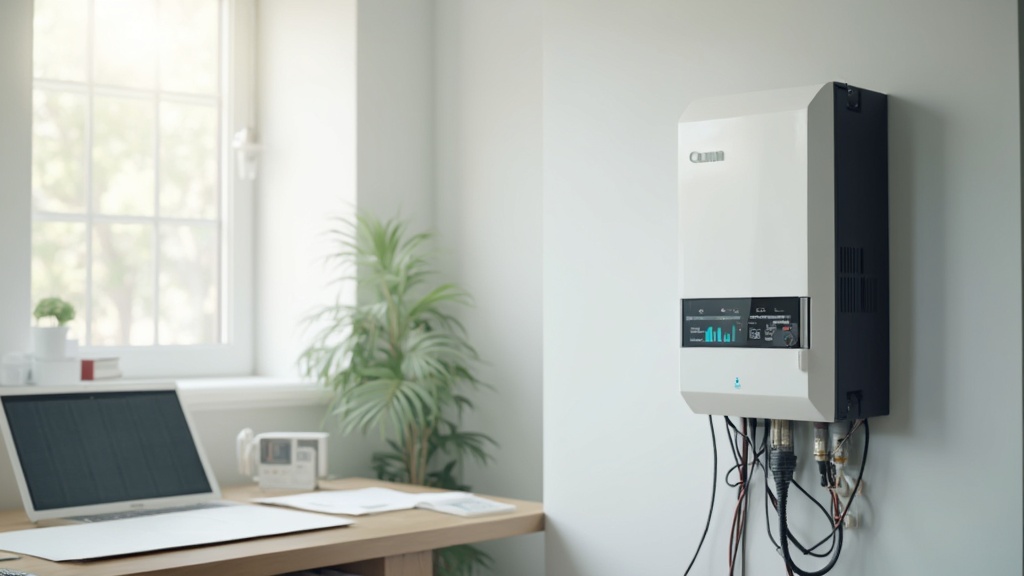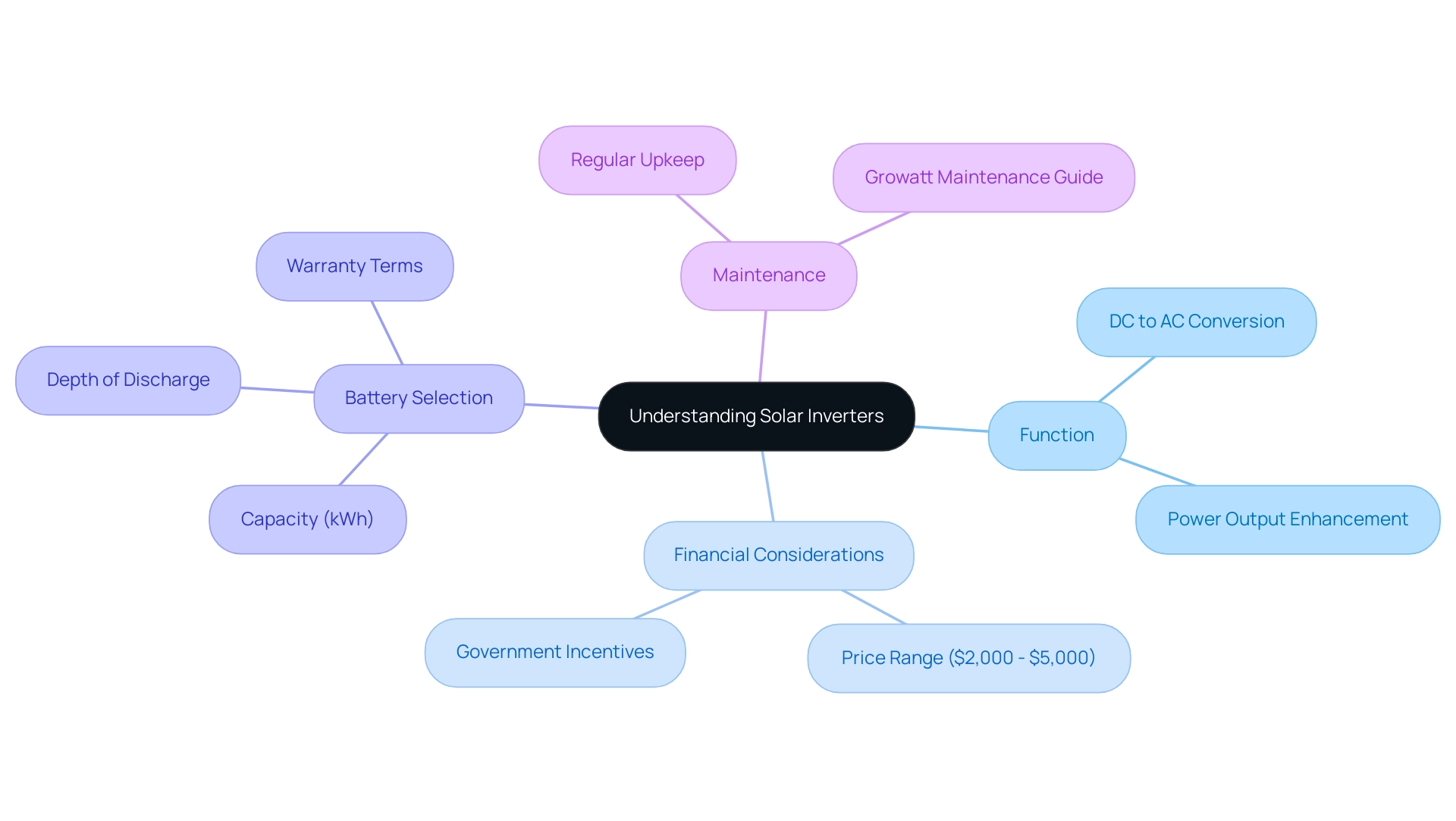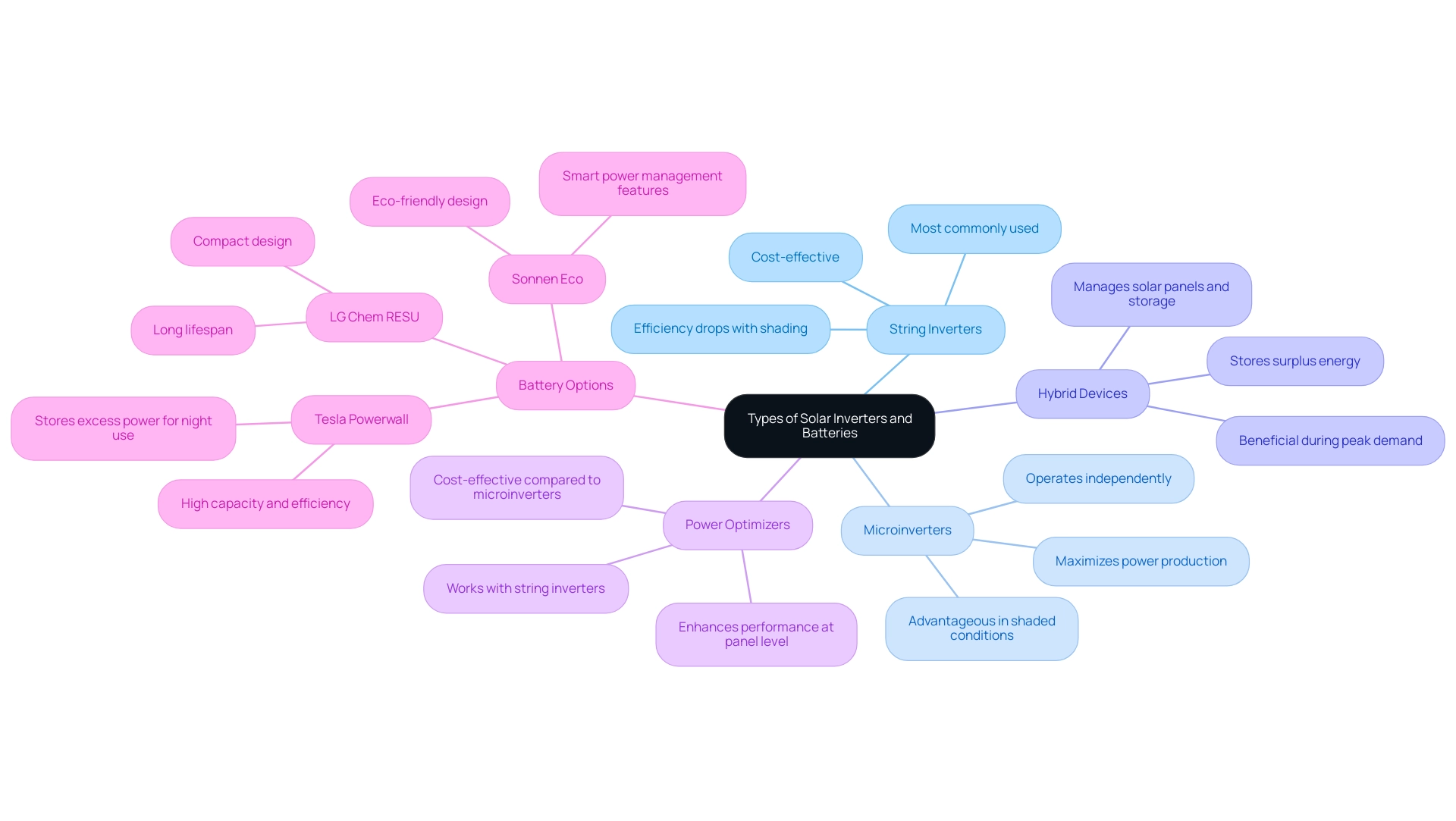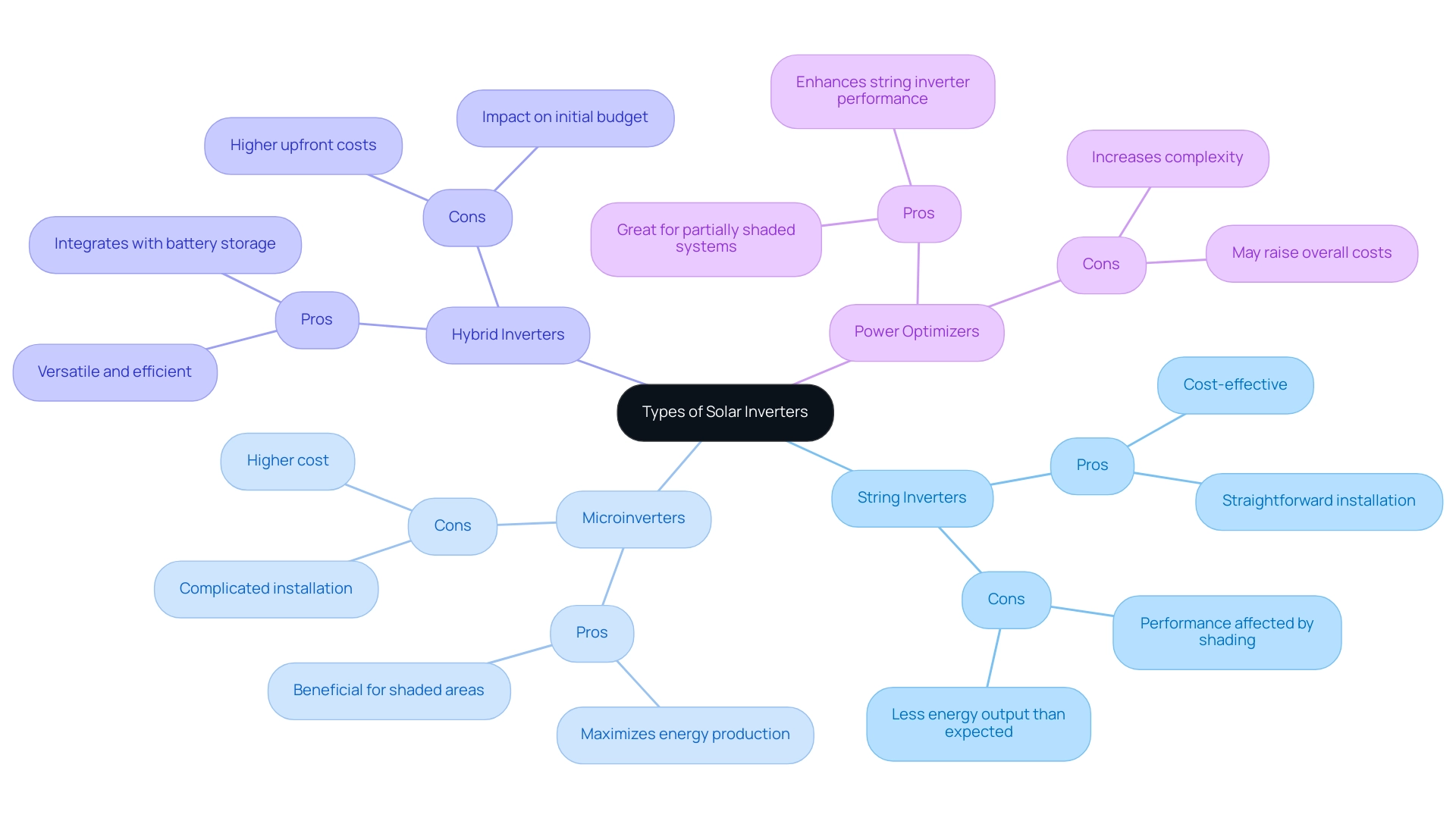Introduction
In the quest for sustainable living, solar energy has emerged as a leading solution for homeowners looking to reduce their carbon footprint and energy bills. At the heart of any effective solar energy system lies the solar inverter, a crucial component that transforms the direct current (DC) generated by solar panels into usable alternating current (AC) for household appliances.
This article delves into the multifaceted world of solar inverters, exploring their vital role in optimizing energy output, the various types available, and essential considerations for selection and installation. With insights into the latest technologies and practical tips for maximizing efficiency, homeowners will find the guidance they need to make informed decisions for a greener, more energy-efficient future.
What is a Solar Inverter and Its Importance in Solar Energy Systems
A photovoltaic device is genuinely the core of any renewable power system. Consider the inverter with solar as the translator between your panels and your home’s electrical needs—it converts the direct current (DC) electricity generated by the panels into alternating current (AC) electricity, which powers most household appliances. However, it does more than merely perform that conversion; a high-quality device enhances the power output from your panels, guaranteeing you receive the best value for your money regarding savings.
Investing in a dependable power converter generally ranges from $2,000 to $5,000, depending on battery capacity and features, making it a vital financial choice for homeowners. Without a quality inverter with solar, your entire system could struggle to operate efficiently, making it essential for maximizing your investment in renewable power. Moreover, evaluating the optimal battery choices for effective power storage is essential; these batteries not only retain surplus power for utilization during peak periods but also improve your home’s sustainability.
When choosing a battery for renewable energy, look for features such as:
- Capacity (measured in kilowatt-hours)
- Depth of discharge
- Warranty terms
These factors significantly impact performance and longevity. Programs promoting renewable resources, such as government incentives, can further alleviate the financial strain, while regular upkeep—like the detailed guidelines offered by Growatt, which provides specific maintenance advice and troubleshooting assistance—ensures your device remains in optimal condition. With the increasing popularity of photovoltaic systems combined with battery storage, especially influenced by California’s net metering policy modifications, having an effective inverter with solar will not only improve your power efficiency but also align with sustainable practices in your residence, contributing to both financial savings and ecological advantages.
How Solar Inverters Work: Converting and Maximizing Energy Output
Devices that are crucial elements perform a key function in converting the power produced by your photovoltaic panels into an inverter with solar. They begin by receiving the direct current (DC) electricity produced by the panels and then use an inverter with solar to convert it into alternating current (AC) electricity. This conversion happens through a fascinating process known as an inverter with solar, where electronic circuits rapidly switch the flow of DC on and off to create a smooth AC waveform.
Under ideal conditions, photovoltaic panels might yield about 80% of their nameplate capacity, which emphasizes the significance of efficiency in the inverter with solar for maximizing energy output.
What’s great about modern conversion devices is that they often include an inverter with solar, equipped with advanced technologies designed to optimize energy output. By modifying the voltage and current to match the requirements of your home’s electrical infrastructure, an inverter with solar can enhance efficiency and guarantee you’re maximizing the benefits of your energy setup. When choosing an inverter with solar, consider best practices such as:
- Checking compatibility with your photovoltaic panels
- Evaluating efficiency ratings
- Understanding the device’s warranty and reliability
Consulting with experts can assist you in making knowledgeable choices that improve your overall power setup.
As renewable power enthusiast Ampster shares, ‘I agree, and I have a configuration that has a DC to AC ratio of greater than 1 to 1… the economics suggested that I could optimize total generation in kWh by increasing the DC capacity.’ This insight emphasizes the need for proper system design, especially as new advancements, like Heterojunction (HJT) technology—which is projected to capture 15% of the global market share by 2030—continue to emerge.
It’s crucial to recognize that equipment failure in an inverter with solar can lead to significant downtime losses, making the reliability of your inverter with solar system paramount. Furthermore, when evaluating storage solutions, explore the top battery options available, such as:
- Lithium-ion batteries
- Lead-acid batteries
This approach not only enhances your home’s energy solutions but also supports economic and environmental sustainability—key considerations for any eco-conscious homeowner.
Types of Solar Inverters: Choosing the Right One for Your Needs
When it comes to photovoltaic inverters, you have a few options to choose from, each bringing its own set of benefits to the table:
- String Inverters: These are the most commonly used type, connecting multiple panels in a series. They are cost-effective—about 35% cheaper than microinverters—but keep in mind that their efficiency can drop if one panel gets shaded.
- Microinverters: Installed on each individual panel, microinverters allow each unit to operate independently. This setup maximizes power production, making it particularly advantageous in shaded conditions.
- Hybrid Devices: These adaptable units can manage both solar panels and energy storage solutions, providing you the ability to store surplus energy for future use, which can be particularly beneficial during peak demand periods.
- Power Optimizers: Similar to micro devices, power optimizers function alongside string units to enhance performance at the panel level. They can improve the efficiency of your system while still maintaining costs lower than a complete microinverter arrangement.
Each variety of inverter with solar has its unique benefits, so it’s crucial to consider factors like your system size, possible shading issues, and your budget. Andrew Giermak, a specialist in the domain, indicates that if you possess a complete battery bank, or your home cannot utilize all the electricity produced by your panels, your converter can effortlessly supply this excess power into the power grid.
Alongside selecting the appropriate converter, choosing the optimal battery is vital for enhancing your storage capabilities. Some of the leading battery options include:
- Tesla Powerwall: Known for its high capacity and efficiency, the Powerwall can store excess power generated during the day for use at night.
- LG Chem RESU: This battery offers a compact design with a long lifespan, making it a popular choice for homeowners.
- Sonnen Eco: Renowned for its eco-friendly design, the Sonnen Eco battery also provides smart power management features.
When selecting a battery, consider key factors such as capacity (how much power it can store), efficiency (how much of that power can be utilized), lifespan (how long the battery lasts), price, and ecological benefits (how it impacts the environment). By making knowledgeable selections regarding converters and batteries, you can enhance your renewable power setup’s effectiveness and adopt a more sustainable way of living.
Selecting and Installing Your Solar Inverter: Key Considerations
Selecting the appropriate inverter with solar is essential for enhancing your photovoltaic system’s effectiveness. Here are some key factors to consider:
- Sizing: Ensure your device can comfortably handle the output from your photovoltaic panels. A mismatch could lead to inefficiencies impacting your energy savings, so it’s vital to get this right from the start.
- Placement: Positioning your inverter matters! Ideally, it should be placed in a shaded area with good ventilation to prevent overheating and keep your system running smoothly.
- Compatibility: Verify that the inverter you choose works well with your current solar panel system and aligns with any future energy storage plans. This foresight can save you time and money later.
- Warranty and Support: Opt for inverters that come with strong warranties and reliable customer support, providing you peace of mind and reducing potential headaches down the road.
Proper installation by a professional is vital to ensure that your system operates at its best. Services such as installation and upkeep are crucial for enhancing the lifespan and effectiveness of your power setup. As emphasized by Fenice Energy, their adaptable inverter with solar battery converters play a crucial role in improving renewable power efficiency, highlighting the significance of choosing the appropriate technology. Inverter with solar chargers are essential for off-grid systems, converting power and charging batteries to ensure reliable power storage even without sunlight. This capability guarantees a reliable power supply, highlighting the practical benefits of this technology. Keep in mind, putting money into the appropriate photovoltaic converter is your initial move toward an effective and sustainable power solution. Furthermore, evaluate the top battery options for effective power storage, as these can enhance your selection of converters and improve your system’s performance. With photovoltaic products being utilized in over 60 countries, the global relevance and success of this technology are clear, promoting energy independence and protection for your home.
Pros and Cons of Different Solar Inverter Types
When exploring the realm of solar devices, it’s important to recognize that each type has its own unique advantages and disadvantages. With insights from over 108 products reviewed, here’s a friendly breakdown to help you choose the best fit for your home:
-
String Inverters:
- Pros: Often the most cost-effective options, these inverters feature a straightforward installation process that many homeowners appreciate.
- Cons: However, if one panel becomes shaded, it can negatively impact the performance of the entire system, leading to less energy output than expected.
-
Microinverters:
- Pros: These little powerhouses maximize energy production from each panel, making them particularly beneficial for homes with shaded areas.
- Cons: On the flip side, they can be more expensive and complicate the installation process.
-
Hybrid Inverters:
- Pros: Versatile and efficient, these inverters can integrate seamlessly with battery storage, allowing you to harness energy even when the sun isn’t shining. Additionally, they offer an always-on setting for continuous operation of low-power devices.
- Cons: Keep in mind that upfront costs are typically higher compared to standard inverters, which might impact your initial budget.
-
Power Optimizers:
- Pros: Designed to enhance the performance of string inverters, especially in partially shaded systems, they can be a great addition to your solar setup.
- Cons: However, they add a layer of complexity and may increase overall costs.
Every homeowner’s situation is unique, so it’s crucial to weigh these factors against your specific energy goals and installation conditions. As Rachel Kurchin, an assistant research professor at Carnegie Mellon University, notes, ‘while a central string inverter usually isn’t on the roof,’ each type of inverter has its role in optimizing your renewable power setup. Furthermore, considering the best battery options for efficient energy storage can enhance your system’s performance, especially when paired with Tesla home chargers and supported by government programs.
By understanding these nuances, along with the benefits of Tesla home chargers, government solar programs, and professional cleaning services, you’ll be empowered to make a well-informed decision tailored to your needs.
Conclusion
Understanding solar inverters is essential for any homeowner looking to harness the power of solar energy effectively. They serve as the critical link between solar panels and home appliances, converting DC electricity to AC while optimizing energy output. With various types of inverters available, including:
- String
- Micro
- Hybrid
- Power optimizers
each option presents unique advantages and considerations depending on individual needs, budget, and installation conditions.
Selecting the right solar inverter involves careful evaluation of factors like:
- Sizing
- Placement
- Compatibility
- Warranty
Professional installation is equally important to ensure the system operates efficiently. A well-chosen solar inverter not only enhances energy savings but also contributes to a more sustainable lifestyle, making it a worthwhile investment.
As the demand for sustainable energy solutions grows, embracing solar technology can lead to significant economic and environmental benefits. By making informed decisions about solar inverters and accompanying battery storage options, homeowners can optimize their solar systems, reduce their carbon footprint, and pave the way for a greener future. The journey toward energy independence starts with understanding and investing in the right tools for success.







